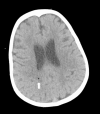Cerebral air embolism in pediatric patients undergoing cardiac surgery
- PMID: 39702304
- PMCID: PMC11661006
- DOI: 10.1186/s13019-024-03152-5
Cerebral air embolism in pediatric patients undergoing cardiac surgery
Abstract
Objective: Cerebral air embolism during Cardio-Pulmonary Bypass is a severe complication with significant neurological risks. We present six pediatric cases, detailing their presentation, management, and outcomes. The discussion reviews existing literature and proposes management guidelines for suspected air emboli.
Methods: A Case Series Report. A retrospective review of medical records was conducted to identify pediatric patients who experienced cerebral air embolism during cardiac surgeries with CPB between January 2009 to December 2023.
Main findings: Throughout the study duration, six patients experienced cerebral air emboli as a complication of their cardiac surgeries. Patients' ages ranged from 8 months to 16 years, with five having single ventricle physiology. Tear-induced cerebral air emboli from right atrium dissection were observed in five cases. Seizures following surgery were the predominant clinical manifestation. Neurological outcomes varied; three patients showed minimal deficits at discharge, while other three cases suffered significant damage leading to substantial deficits.
Conclusions: We present a case series documenting the occurrence of a rare complication-cerebral air emboli-during cardiac surgery in children. Our study highlight a spectrum of neurological outcomes in affected patients and provides guidelines for the identification and treatment of this complication.
© 2024. The Author(s).
Conflict of interest statement
Declarations. Competing interests: The authors declare no competing interests.
Figures
References
-
- Kim DY, Park CI, Yu SJ. Cerebral Air Embolism during Open Heart surgery with cardiopulmonary bypass. Korean Circ J. 2012;42(9):647–50.
-
- Olga L, Quintero MD, Juan C, Giraldo MD, Néstor F, Sandoval MD. Successful management of massive air Embolism during Cardiopulmonary Bypass using Multimodal Neuroprotection Strategies. Semin Cardiothorac Vasc Anesth 1–9. 2018. - PubMed
-
- Huber S, Rigler B, Ma¨chler HE, Metzler H, Smolle-Ju¨ttner FM. Successful treatment of massive arterial air Embolism during Open Heart surgery. Ann Thorac Surg. 2001;71(5):1664–6. - PubMed
MeSH terms
LinkOut - more resources
Full Text Sources
Medical



